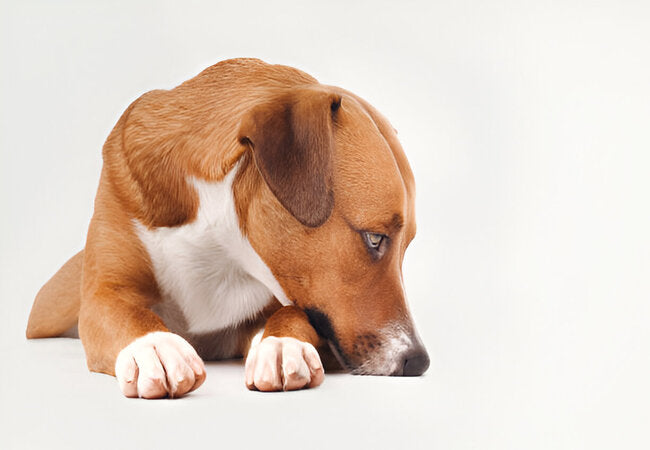2025 Vet Insight: Can Dogs Feel Embarrassed? Decoding Canine Emotions 🐶😳

In this article
2025 Vet Insight: Can Dogs Feel Embarrassed? Decoding Canine Emotions 🐶😳
By Dr. Duncan Houston BVSc
Hello, I’m Dr Duncan Houston BVSc, veterinarian and founder of Ask A Vet. We've all seen it—the guilty look, head down, ears back, avoiding eye contact. But is your dog really embarrassed, or is something else going on? In this 2025 vet insight, we'll explore canine emotions, the subtle body language behind those looks, and how we can respond with empathy and clarity.
1. The Science Behind "Guilty" and Embarrassed-Looking Dogs
Studies show that dogs producing a “guilty look” are responding to your tone or body language—not feeling shame or embarrassment as we understand it. They’re reacting to perceived tension. So that sad face? It’s fear or appeasement, not embarrassment.
2. Canines and Complex Emotions: What's Real? 🤔
Emotions like fear, anxiety, joy, and excitement are well-documented in dogs. But complex self-conscious emotions—embarrassment, shame, guilt—are less certain. Experts suggest dogs may feel simplified versions of self-consciousness. However, attributing human embarrassment may be anthropomorphism.
3. Why Dogs Look "Embarrassed" (But It's Usually Fear or Respect)
- Fear of reprimand: Learned to expect negative reaction from past behavior—makes them appear remorseful.
- Appeasement behavior: Ear flattening, avoiding eye contact, and lowered posture—all signals to reduce conflict.
- Conflict between desire and restraint: Wanting to engage but cautious about your reaction—this hesitation may look like embarrassment.
4. Signs Often Mistaken for Embarrassment
4.1 Avoidance & Attention-Loss
After a mistake (like rummaging through trash), your pup may avert gaze or retreat, anticipating displeasure, not feeling embarrassment.
4.2 Subtle Body Language
- Ears pinned, head lowered, tail tucked, body turned away
- Whale eye (showing whites of eyes) and lip licking—classic stress signals.
4.3 Freezing or Submission Posture
Tense posture and brief freeze signal discomfort—often mislabeled as embarrassment.
5. How to Support Your Dog When You See "Guilty" Behavior
- Stay calm: Avoid raised voices or harsh body language that triggers fear.
- Use positive reassurance: Offer soft praise, treats, or a gentle ear rub.
- Focus on training—not punishment: Teach alternative behaviors like “leave it” or place commands.
- Manage environments: Puppy-proof trash bins, gates, and secure tempting items.
6. Training Tips to Build Confidence & Communication
- Redirect choices: Use “what’s next?” or use puzzle toys (like from Woopf) to refocus behavior.
- Teach calm cues: Offer mat/stay behaviors and reinforce with praise or treats.
- Set up for success: Prevent mistakes by controlling the environment, then praise after correct behavior.
- Encourage curiosity: Reward sniffing or calmly exploring new items, even after mistakes.
7. When to Watch for Real Emotional Distress
Look out for these serious signs:
- Avoidance, freezing, panting, drooling, shaking—all stress indicators.
- Ongoing anxiety, phobias, or fear triggers—consider vet consultation via the Ask A Vet app.
- If body language signals aggression or severe fear, better consult a professional behaviorist.
8. FAQs on Canine Embarrassment ❓
- Q: My dog looks ashamed when scolded—is that embarrassment?
- A: No—they are reacting to perceived tension or expecting a negative outcome, not true embarrassment.
- Q: Can dogs recognize when we laugh at them?
- A: Yes. Dogs are attuned to human expressions and voice tone—they can mirror emotions and may show tentative behavior in those moments.
- Q: Is hugging them a good comfort?
- A: Only if your dog finds it soothing. Some dogs feel more stress when physically restrained—always watch their comfort cues.
9. Ask A Vet App for Real-Time Behavior Help
With the Ask A Vet app, you’ll get:
- Live video assessment of your dog’s behavior signals
- Guided advice on building confidence and redirecting from mistakes
- Product suggestions for mental enrichment tools (Woopf) and calming aids (Purrz)
- Access to behavior training timelines and progress tracking
🩺 Final Vet Insight
While dogs likely don’t feel embarrassment in the human sense, they do exhibit emotional states—fear, uncertainty, self-consciousness—that look like it. Judging by your tone or actions, they adapt their behavior in helpful ways. Remove the judgment, nurture trust, and support growth. Your dog isn’t ashamed—they’re listening. And you’re teaching them love, safety, and clarity. 🐾❤️






